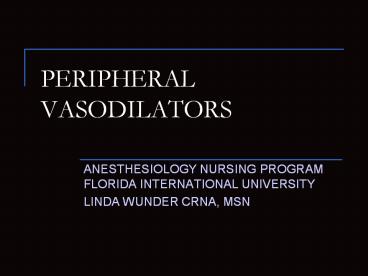PERIPHERAL VASODILATORS - PowerPoint PPT Presentation
1 / 22
Title: PERIPHERAL VASODILATORS
1
PERIPHERAL VASODILATORS
0
- ANESTHESIOLOGY NURSING PROGRAM
FLORIDA INTERNATIONAL
UNIVERSITY - LINDA WUNDER CRNA, MSN
2
PERRIPHERAL VASODILATORS
0
- Treat hypertensive crisis
- Produce controlled hypotension
- Facilitate left ventricular forward stroke
volume, as with patients with regurgitant
valvular heart lesions or acute cardiac failure - Conceptually, vasodilators decrease systemic
blood pressure by decreasing systemic vascular
resistance (arterial vasodilators) or by
decreasing systemic venous return and cardiac
output (venous return)
3
NITRIC OXIDE (NO)
0
- NATURALLY OCURRING POTENT VASODILATOR RELEASED BY
ENDOTHELIAL CELLS ( EDOTHELIUM-DERIVED RELEASING
FACTOR) - ULTRA SHORT HALF LIFE lt5SEC
- INHALED (NO) IS A SELECTIVE PULMONARY VASODILATOR
USED FOR THE TREATMENT OF REVERSIBLE PULMONARY
HYPERTENSION - CAN IMPROVE OXYGENATION OF ARDS AND ONE LUNG
VENTILATION - MAY HAVE ANTI-INFLAMATORY EFFECTS
4
SODIUM NITROPRUSSIDE
0
- NIPRIDE
- Emergent blood pressure control
- Hypotensive techniques
- Treatment of pulmonary edema
- Onset within seconds
- Rapid termination of effect 1-3 minutes after
discontinuation
5
SODIUM NITROPRESSIDE
0
- Direct reduction in preload
- Direct reduction in afterload
- Decrease in peripheral vascular resistance
- No direct myocardial depressive effects
- Stroke volume tends to increase as a benefit of
afterload reduction - Pure afterload decreases preload which decreases
myocardial work and O2 requirements and the
likely hood of ischemia - Reflex tachycardia
- Dilatation of coronary arteries, coronary steal
6
SODIUM NITOPRUSSIDE
0
- Reductions in pulmonary artery pressure may
decrease the perfusion of some normally vented
alveoli, increasing physiologic dead space - May prevent the normal response of the pulmonary
vasculature to hypoxia (hypoxic pulmonary
vasoconstriction) by dilating pulmonary vessels
7
SODIUM NITROPRUSSIDE
0
- Given intravenously
- Start small if possible0.5ug/kg/min
- Rarely exceed 3ug/kg/min
- Bolus doses of 1-2ug/kg are found to be effective
in blunting the hypertensive responsive response
to intubation - Mixed in 5 Dextrose
8
SODIUM NITROPRUSSIDE
0
- Bottle must be protected from lightactive
ingredients decompose in light - Always give with an infusion pump
- Nearly always have arterial pressure monitoring
- Avoid administration in the same line as
sympathomimetics - May cause nausea and vomiting
9
SODIUM NITROPRUSSIDE
0
- CYANIDE TOXICITY
- SNPOXYHGB?(SNP)- METHEMOGL
- 5CN-
- CN- METHEMOGL-?CYANMETHEMOGL
- Rhondanase, B12
- CN- THIOSULFATE---------?THIOCYANATE
- CN- CYTOCHROME OXIDASE?CYANIDE
-
TOXICITY
10
CYANIDE TOXICITY
0
- EARLY SIGN-TACHYPHYLAXIS
- METHHEMOGLOBINEMIA
- INCREASED MVO2 CONTENT
- TACHYCARDIA
- INCREASED ICP
- METABOLIC ACIDOSIS
11
CYANIDE TOXICITY
0
- INFUSIONS OF 8-10 UG/KG/MIN FOR GREATER THAN 3
HOURS SHOULD BE AVOID - CHRONIC ADMINISTRATION SHOULD NOT BE GREATER THAN
0.5/UG/KG/MIN
12
TREATMENT OF CYANIDE TOXICITY
0
- DISCONTINUATION OF INFUSION
- ADMINISTER OXYGEN
- TREATMENT OF ACIDOSIS
- SODIUM THIOSULFATE150MG/KG OVER 15MINS
- 3 SODIUM NITRATE5MG/KG OVER 5MINS
- METHOGLOBINEMIA CAN BE TREATED WITH METHLENE BLUE
1-2MG/KG OF 1 SOLUTION OVER 5MINS (PULSE OX
WILL NOT WORK WHILE ADMINSTRATING METHLENE BLUE)
13
NITROGLYCERIN
0
- Indications
- Angina, hypertension, myocardial ischemia
- Mechanism of action
- Relaxes vascular smooth muscle, with venous
pooling - Metabolism to nitric oxide to increase cGMP,
decrease intracellular calcium, and vascular
smooth muscle relaxation
14
NITROGLYCERIN
0
- Decrease preload
- Decrease left end-diastolic pressure
- Decrease myocardial O2 demand
- Increase endocardial perfusion
- Relieves coronary spasm
- Redistributes coronary blood flow to ischemic
areas - Relaxes bronchial smooth muscle
- Provides uterine relaxation
- Relaxes sphincter of oddi
15
NITROGLYCRIN
0
- Glass bottle used
- Special tubing available
- Not as potent as nitroprusside
- Can potentiate the effects of pancuronium
- Can cause headache in awake patients
16
NITOGLCERIN
0
- Diluted to 100ug/ml
- .5-10ug/kg/min
- SL peak in 4 min
- Transdermal sustained release for 24 hours
- Can give small bolus if needed until drip is
ready like 50ug, if B/P is high
17
HYDRALAZINE
0
- Mechanism of action
- Direct relaxation of arterial smooth muscle
- Indication-control hypertension
- Causes TACHYCARDIA (use when patient is
hypertensive and bradycardic) - IV 5-20mg, onset up to 15 min, lasting 2-4 hours
- 20mg per 1 cc (mix 1cc in 3cc of saline5mg/cc)
- Can be used Pregnancy induced hypertension
18
TRIMETHAPHAN
0
- Peripheral vasodilatation by direct smooth muscle
relaxation and by blockade of acetylcholine
receptors in autonomic ganglia - Used to control AUTONOMIC HYPERREFLEXIA in
patients with upper spinal cord injuries - Inhibits plasma cholinesterase and can double
succinylcholine, potentiates non-depolarizing
muscle blockade
19
ADENOSINE
0
- Purinie endogenous to all cells of the body
- Acts on the receptors located in several vascular
beds and on the AV node - Opens potassium channels, hyperpolarizing nodal
tissue and making it less likely to fire - Leads to an AV block and slows sinus rate
20
ADENOSINE
0
- Potent vasodilator and can be used for reduction
of B/P under anesthesia - If affects afterload
- 60-120ug/kg/min for controlled hypotension
- Only approved by FDA for SVT
- 6mg 1-2 seconds, 12mg 1-2 seconds may repeat once
21
ADENOSINE
0
- Erythrocytes and vascular endothelial cells
metabolize it toinosine and adenosine
monophophate - Coronary vasodilatation can lead to coronary
steal in patients with CADmyocardial ischemia - Methlxanthines (aminophylline) competitively
antagonize adenosine
22
0
- .































